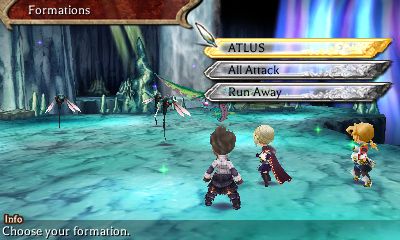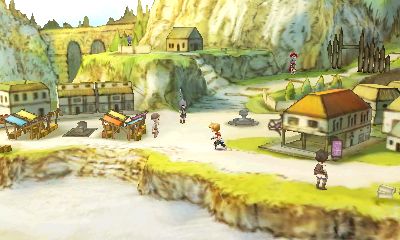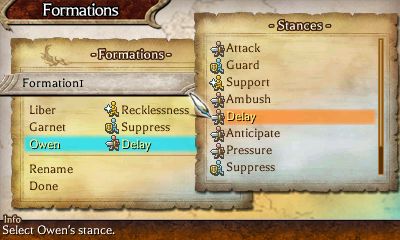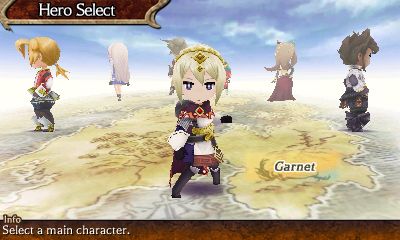The Legend of Legacy won't coddle you. Although it may look like another familiar RPG in the style of older Dragon Quest and Final Fantasy titles, Legend of Legacy is a sprawling adventure where combat can get more than a little grueling. Unfortunately, that journey is also marred by plenty of forced grinding and and indistinct objectives, making this game a flawed experience despite its promising elements.
The game begins with you choosing from one of seven heroes to travel to the remote island of Avalon, which a decade ago emerged from the ocean. The mysterious land has been settled by an eccentric fellow who now serves as its king. He sits on a comfy throne, flanked by several guards, and he beckons adventurers to his domain where they are free to explore local ruins and keep whatever treasure they find.

The first stop on the island is the town of Initium, which serves as your home base for the campaign. You can buy new gear and sell treasure and information here, or you can pay to send a boat out to sea in search of treasure. You'll find and recruit other heroes, as well, but only three characters can ever be in your active party at once. Plot developments throughout the campaign are usually presented in the form of a few lines of vague dialogue as you enter or clear new dungeons. You'll also occasionally come across stones inscribed with poems that contain story details. Theoretically, you can take each of your characters through the game's story mode once, but not enough changes from one tour to the next to justify doing so.
The island is an interesting place. Dungeon environments feature familiar elements so popular within the RPG genre--earth, fire, and water, mostly--but somehow feel fresh thanks to their unique presentation. Obstacles such as trees, treasure chests, and shrines pop into place as you roam, as if a magical brush is swiping across the screen just ahead of you. It's fun to see what appears, particularly when you're making your first forays into uncharted territory, but things get tense because you're almost never alone.
Monsters patrol the narrow trails that wend their way through most regions, and they'll chase you relentlessly once they spot you. You can flee, but then you might run into a separate group or even trigger an environmental hazard that temporarily lowers your characters' maximum HP. Eventually, you'll become familiar with the local terrain and you get a feel for enemy patrol patterns, which is fairly unique within the genre.

Combat, much like the dungeons, looks and sounds beautiful. The battle system is turn-based and the camera focuses on whichever character is receiving or executing orders. Monsters tend not to move far from their starting positions when they attack, and the same is true of the heroes (they just swing a blade in the general direction of unpleasant wildlife). Even so, battles are dynamic thanks to the quick camera cuts and satisfying sound effects such as the clang of claws clanking against metal or swords striking down oversized lizards. You'll probably also want to play for a while with the 3D effects enabled, if only to check out the backdrops. They resemble watercolor paintings, and a lot of them have surprising depth.
Combat is both unique and challenging, ensuring that virtually any mob of enemies you encounter has the potential to cut your adventure short even after you've levelled up your characters. Everyone's health is restored to its current maximum after every battle, but elemental energy--a critical resource that enables you to control the elements and use skills associated with them--is not. You need to maintain your SP by fighting carefully and planning for future skirmishes, lest you head into another confrontation and find that you lack the means to quickly eliminate or defend against an especially vicious adversary. If a fight goes wrong right from the start, recovery is difficult.
When you venture into a new region, the new monsters you encounter within it are typically quite robust and they will easily overwhelm you. If you just barely manage to scrape by, though, that's good enough. You can continue exploring without stopping to use healing items and spells the way you might have to in some other games. Often, you can run from a fight, but you'll warp back to the dungeon entrance in that case, even if you had ventured several maps into its depths. That's discouraging, but still worth doing because if you let a standard mob defeat your party, you'll lose all of your progress. As the game's NPCs suggests when you talk to some of them back in town, it's better to run away than it is to die on the battlefield. At least that way, you gain information--map data, in particular--that will prepare you for your next journey through that particular dungeon, and your party members retain their previous combat experience.

Unfortunately, some aspects of the game's design fall flat. You'll rarely win battles simply by mashing buttons, which forces you to remain engaged. That seems like it would be a good thing, but all too often, you're simply following convoluted procedures that don't entertain you even though they demand your attention. The main culprit is the elements system, which is unique but also tedious and surprisingly complex.
Any given battlefield is ruled by one or more of four elements: lightning, fire, air, and shadow. Over the course of the adventure, you'll gain the ability to manipulate those elements by equipping special crystals, and from that point on you have to play tug-of-war with your adversaries, sometimes managing multiple elements at once. Suppose you summon the fire element. Once it has materialized, that fire remains in play for the remainder of the battle. While it is localized to your half of the battlefield, you can use any associated skills that you may have memorized or can otherwise extract from equipped crystal shards. In subsequent rounds, you can continue stoking the flames by summoning more fire. This will increase that element's influence on the battle, weakening any other elements that are also in use.
However, one of your enemies might end a turn--or preempt one of your moves in the middle of a round--by calling the flames over to the opposite side of the field. Suddenly, none of your fire-related skills work unless you spend your next turn dragging the element closer to your warriors, which you'll be especially anxious to do if you previously spent several turns building up a powerful resource and your foes just stole it. Of course, taking it back uses up one of your party member's turns that could otherwise be spent dealing damage, and potentially allows that same foe to steal it yet again. You might also miss out on health or magical energy restoration in the process, which means you have to make up for it somehow. When you face large mobs in the later areas, battles drag on for quite some time while everyone wrestles over two or three elements, to the point you'll want to avoid skirmishes even when you're fairly certain you can win.

Dodging battles isn't always advisable even when it's possible and tempting, though, because you need to improve your characters. Unlike many other RPGs, party members in Legend of Legacy gain proficiencies in various job "stances"--attacking, defending, and using support skills--based on the formation you assign to them outside of battle.
Separately, they also master different weapon classes and spells through repeated use. You might equip Owen with a trident, for instance, and instruct him to maintain an attack stance. Over time, he'll use the weapon to destroy a bunch of foes, and he'll access new skills that gain proficiency levels individually. If you want to switch him to a staff or bow and arrows from there, he'll start using that weapon with a proficiency rating of 1 and no enhanced attacks, but retain any boosts to his general ATK stance that he gained along the way.
As you advance through the game, stronger versions of a particular type of weapon are few and far between, but other types of gear might be abundant. You're practically forced to jump into a different fighting style every couple of dungeons or so as a result. Whether you switch from one discipline to another or stick to a favorite piece of equipment, you're going to have to constantly grind to stand a chance in the wilderness. And of course, swapping out party members is practically out of the question, unless you have hours to burn.

It can also be difficult to figure out what you're supposed to do next. The game design isn't strictly linear, but there does seem to be a general order in which you should explore dungeons to avoid being slaughtered. You progress through the campaign by unlocking new regions, either by thoroughly exploring the dungeons currently available to you or (sometimes) by paying the town merchant to sell you maps. That's the extent of the guidance you'll get. Beyond that, you're almost entirely on your own and have to decide whether you keep hitting a wall because you're in the wrong location or because you just need to grind for a few hours. NPCs will talk about the various local dungeons, but they won't provide tips about where to go next, and the King of Adventurers is generally content to encourage you to keep exploring without getting specific. Sometimes the only way to figure out how to access the next area is to revisit every zone you've already cleared in case you missed something or in case defeating a boss in one dungeon caused a magical portal to appear near the end of a different region you already cleared.
The Legend of Legacy boasts a lengthy campaign set amidst one of the most hostile but beautiful worlds you'll ever see realized on the 3DS hardware. That experience requires you to first come to terms with challenging and sometimes tedious combat, though, plus you'll have to endure a lot of grinding in order to turn your team into the group of warriors that can survive to the end. They say beauty is only skin deep, and in this case, there's definitely a lot of roughness under the surface.